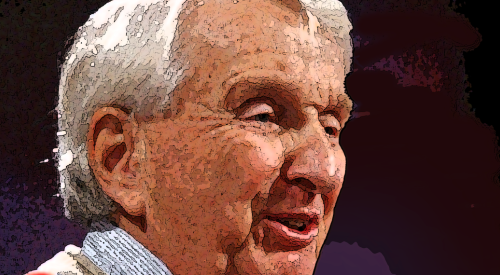| Contact Scott Sedam via e-mail at scott@TRUEN.com
|
In an otherwise dreary and cold March in the Northeast, something exciting and unusual was about to happen. The community had received a tip. The president was coming — from a land far, far away. He would travel hundreds of miles to see the hottest new project in the company, in a division that recently had been reborn under new management.
“Glenbrook” had innovative new product on a beautiful wooded, rolling site across from a new school, which had a great play yard and basketball courts courtesy of the developer. It was hot, hot, hot.
Tom, the service manager, and Lou, the project manager, decided to go all out. They pulled the Glenbrook team together and told them the deal. They would knock the president’s socks off.
For two weeks, the team swept streets, straightened lumber piles and emptied trash bins. New portable toilets were ordered. The suppliers and trades were brought into the act, and everyone pitched in.
The day before the big event, the field secretary called the home office to find out what kind of coffee the president liked and his preferred morning fare. The goods were secured.
Then the day arrived — a very foggy morning, the foggiest in memory. You could hardly see across the road, but everyone made it on time and gathered at the construction trailer. It, of course, had been scrubbed down even to the gritty back steps. The whole team was there, including a select group of 10 key suppliers and trades who would be introduced to the president as key members of the Glenbrook team. The coffee was brewing, the cinnamon buns were warm, and the various “offerings” from the trades — mostly logo shirts and caps — were laid out on a table. Everything was perfect. The excitement grew, and then they appeared.
John, the regional president, turned into the gravel lot just in front of the trailer. John was on his cell phone. Mark, the company president and guest of honor, sat in the passenger seat, also on his cell phone. It must have been a conference call, because John and Mark seemed to be exchanging comments and giving each other hand signals and knowing looks. For more than 30 minutes, the project manager peeped through the blinds and reported back to the throng gathered in the trailer. Finally he shouted, “Get ready, they just hung up!” The excitement was palpable.
And then silence, and then an “Oh my God, I can’t believe this!” Mike, the service manager, rushed to the window and looked out. There, fading into the foggy mist, were the two red taillights of the Mercedes, quickly growing dimmer until in a few seconds they vanished in the mist. Sounding more wishful than factual, Mike said, “They’ll be back. Probably just went to look at something. Let’s hold on.”
The team waited. After 15 minutes, the trades decided to go back on the job. Then, one by one, the team members returned to their desks or ventured into the field to check on houses.
The Mercedes never returned. Late that afternoon, the president flew back home. At 6 p.m., the project manager dumped the uneaten cinnamon rolls in the trash.
The team members were devastated and embarrassed. They were subject to months of occasionally unkind ribbing from members of other communities. People left them phone messages saying things like, “Hey, we heard that Wayne Newton is coming to visit you guys. We hear he likes caramel pecan rolls!”
But similar preparations had been made in the main office, and the president had never showed there, either. It turned out he and John had been distracted by some hot land deal and had to go check it out. Never mind that the company president had virtually no knowledge of that local market and was virtually useless in terms of helping the locals decide on the deal. That’s what presidents do, I guess. Priorities.
Even a month later, the whole group was really down about it. The attitude toward anyone from outside the operation was less than hospitable. Everyone acted like a kid whose daddy had failed to show up for the birthday party.
Were the team members overreacting? Maybe. Shouldn’t they have just sucked it up? Well, in truth, they had. But there was a lingering resentment and disappointment. These people had worked hard; they had turned it around and now owned one of the company’s premier communities, and in their minds the president just didn’t care about them or their project.
As a consultant, it was my job to tell the president things he didn’t really like to hear. We had this deal that he always would listen, even when it made him angry. I reluctantly told him the story, and in about three seconds he jumped out of his chair, threw up his hands and asked how the heck he was supposed to read everyone’s mind in the field. Then he sat back down, sighed and said simply, “OK. I get it. What we did was wrong. I just had no idea. Can we fix it?”
And that very week he made an excuse to return to that division and the star community. He spent a lot more time there than he normally would have. He shook everyone’s hand, thanked all the team members, admired their work and told them how proud he was of them that they had turned their division around. He stopped at the division office and went through the same routine. He joked that it sure was nice to be able to see the project this time, unlike his last visit in the fog. And no one was cynical. Everyone bought the program — because he was utterly sincere. That division went on to have a record year.
Just another communication story? Sure, but I have seen this and similar lessons in communication played out time and again. Someone neglects to show up for a meeting or sends the wrong person. Someone refuses to confront an individual performance issue and addresses it by issuing blanket directives and admonitions to an entire group. A sensitive issue comes up, and instead of meeting face to face, someone sends a memo — or even worse, an e-mail. Someone forgets to return a call or simply acknowledge a contribution or even a presence.
I have not only seen it, I have lived it, having committed all these errors on multiple occasions.
Of course, one of the biggest problems is that most of us commit these communication faux pas without realizing either the act or, worse, the impact. Count yourself among the lucky few if you have someone who will tell you to your face when you blow it. But few people have the guts to tell you, especially if you’re a senior manager. Trust me on this.
So you might want to make a deal like the president had with me. Pick someone you trust and tell that person it is his or her job to tell you when you screw up. Empower that person, and back off if you’re told that how the person knows what he or she knows can’t be divulged.
I had a wise old professor (yeah, there was one) in graduate school who used to caution his students that communication is never the problem but is often a symptom. He was saying that if you or your people talk about communication problems, you’d better look deeper for the cause.
I often have found this to be true, and frequently the problems run deep. They are tied up in behavior styles, personalities, company policies, structures and culture. But at other times, it is simple human oversight. It’s the result of being too busy and allowing ourselves to be distracted, so much that we miss the little things, which left unresolved tend to become big, even huge things.
Start with the little things. Get those resolved, and you might have time to look deeper. And don’t leave anyone staring at your taillights, fading in the mist.












